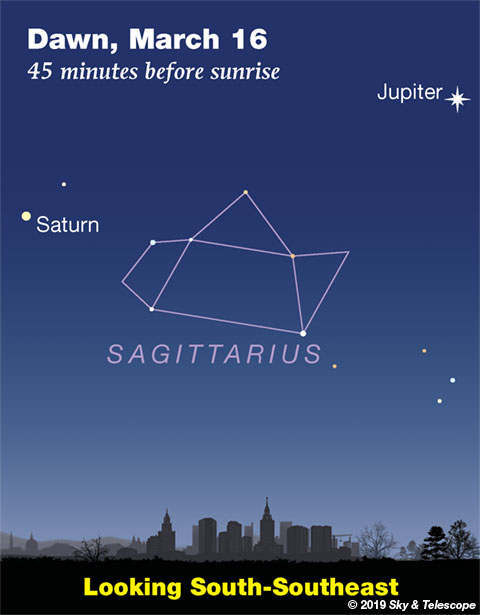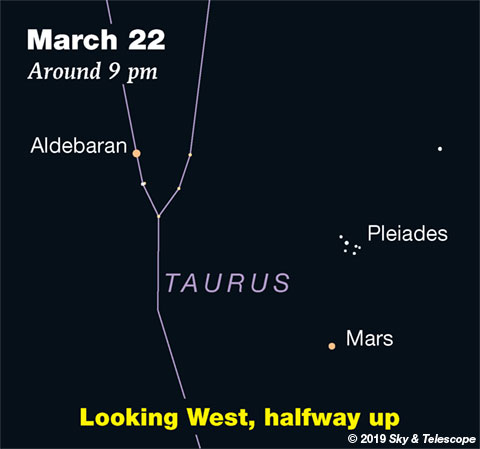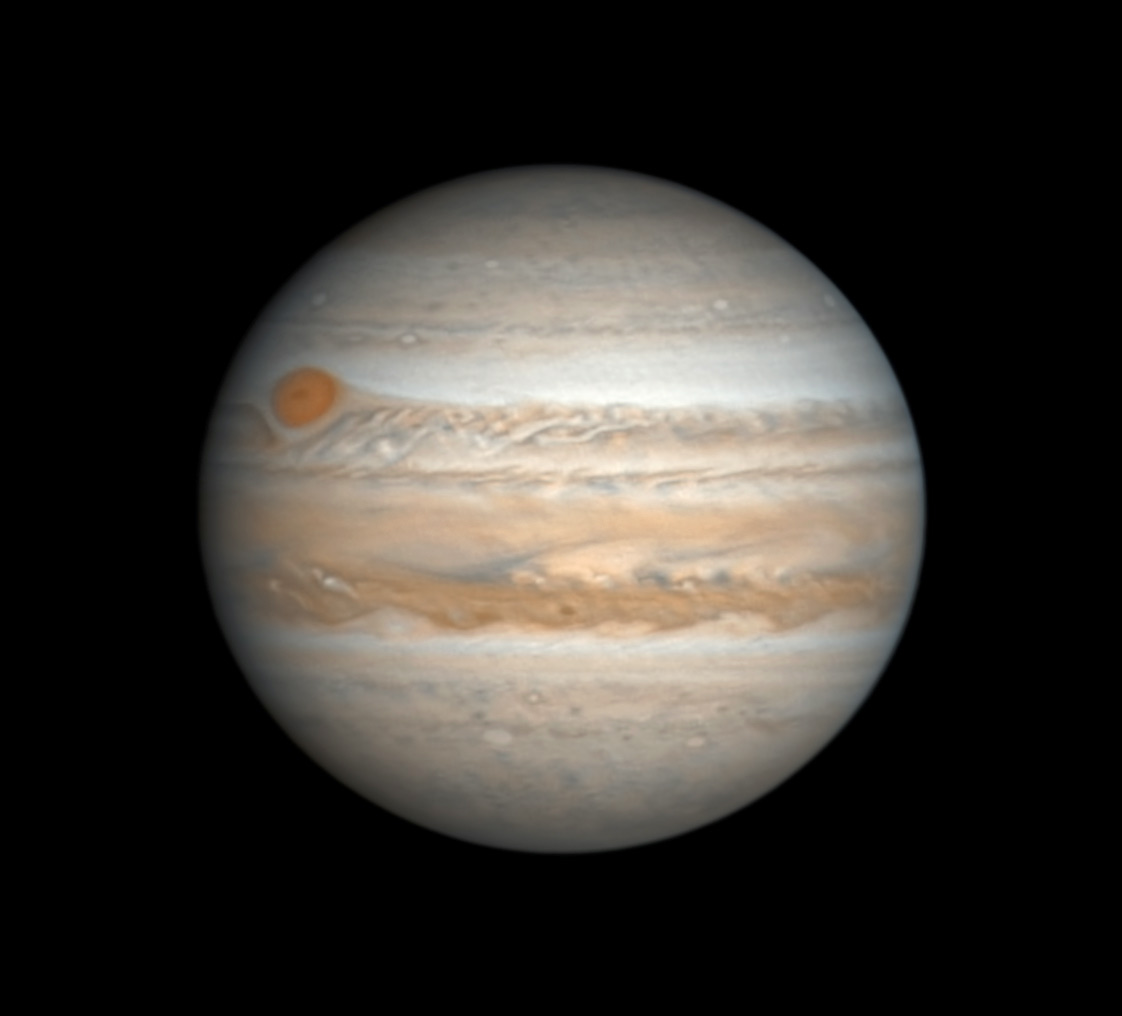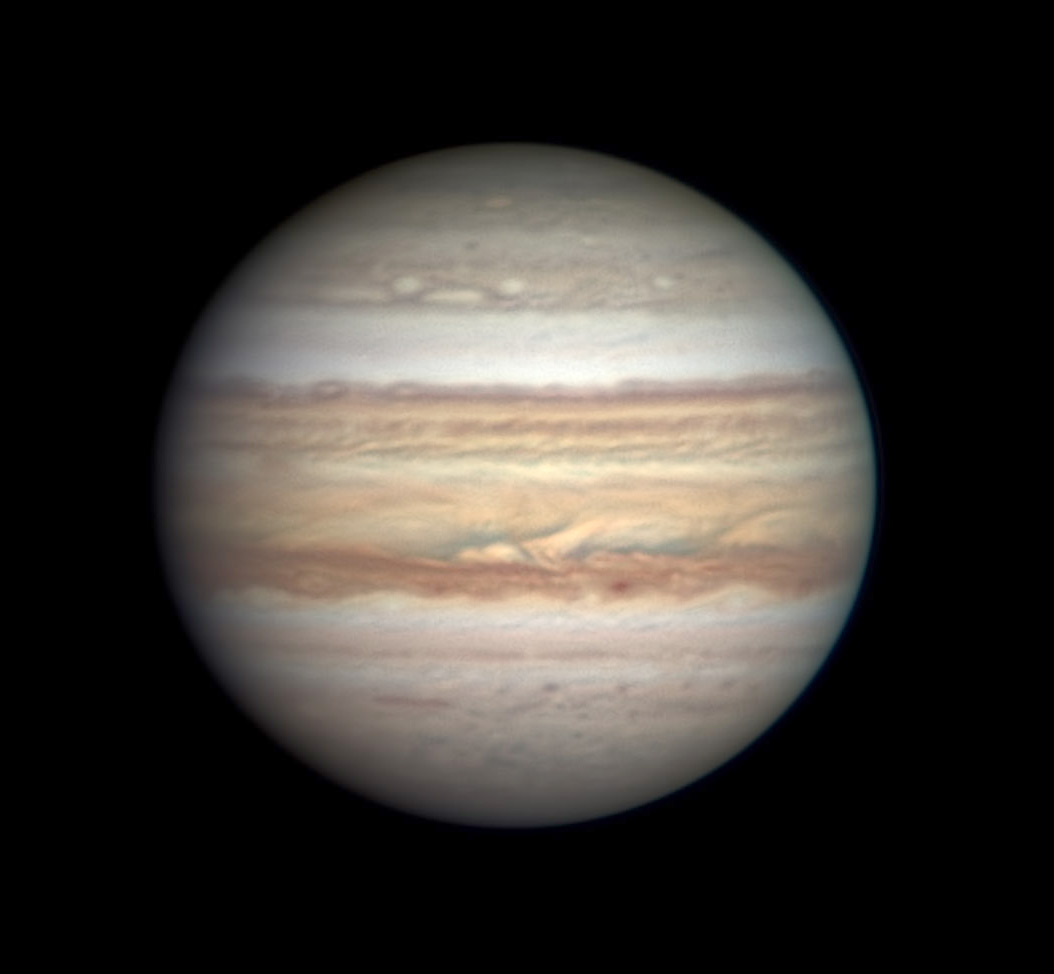Friday, March 15
• Look for Arcturus, the Spring Star, very low in the east-northeast after nightfall and higher in the east later in the evening. By modern measurements Arcturus is visual magnitude –0.05, making it the fourth-brightest nighttime star. It's bested only by Sirius, Canopus, and Alpha Centauri (if you combine the light of Alpha Cen A and B, because the pair appears single to the unaided eye).

Saturday, March 16
• Very high after dark, Castor and Pollux point almost at the waxing gibbous Moon near them.
• The Big Dipper glitters softly high in the northeast these evenings, standing on its handle. You probably know that the two stars forming the front of the Dipper's bowl (currently on top) are the Pointers; they point to Polaris, currently to their left.
And, you may know that if you follow the curve of the Dipper's handle out and around by a little more than a Dipper length, you'll arc to Arcturus, rising in the east.
But did you know that if you follow the Pointers backward the opposite way, you'll land in Leo?
Draw a line diagonally across the Dipper's bowl from where the handle is attached, continue far on, and you'll go to Gemini.
And look at the two stars forming the open top of the Dipper's bowl. Follow this line past the bowl's lip far across the sky, and you crash into Capella.
Sunday, March 17
• This is the time of year when Orion declines in the southwest after dark, with his Belt roughly horizontal. When does Orion's Belt appear exactly horizontal? That depends on where you're located east-west in your time zone, and on your latitude.
Can you time this event? If you're near your time zone's standard longitude, expect it around 9:15 this evening (daylight-saving time). . . more or less.
Monday, March 18
• The bright waxing gibbous Moon traverses the sky in company with 1st-magnitude Regulus tonight. They're only a couple of degrees apart in early evening (for North America). Watch them pull farther apart hour by hour.
Tuesday, March 19
• The Moon, almost full, shines in the dim hind feet of Leo. Upper right of it after dark is Regulus, about a fist and a half at arm's length away.
Left of the Moon by about half that distance is Denebola, Leo's tailtip. Denebola is 0.8 magnitude dimmer than Regulus (meaning about half as bright) and it'll also be closer to the Moon's dazzling glare. Depending on the clarity of your air, Denebola may or may not be a challenge to pick out.
Wednesday, March 20
• Full Moon (exact at 9:43 p.m. EDT), and this qualities as a supermoon; it's just two days after perigee. The Moon shines a trace bigger and brighter than usual, in the head of Virgo under Leo.
• Coincidentally, today is also the equinox. Spring begins (in the Northern Hemisphere) at 5:58 p.m. EDT, when the center of the Sun crosses the equator heading north for the season. The Sun rises and sets almost exactly east and west, and very nearly 12 hours apart. (And no, eggs don't balance any better than they usually do!)
Thursday, March 21
• Now that it's spring, the signature fall-and-winter constellation Cassiopeia is retreating downward after dark. But for skywatchers at mid-northern latitudes Cassiopeia is circumpolar, never going away completely. Look for it fairly low in the north-northwest these evenings. It's standing roughly on end.
By midnight or 1 a.m. it's at its lowest due north, lying not quite horizontally.
• Algol, descending in the northwest, should be at minimum light for a couple hours centered on 10:04 p.m. EDT (7:04 p.m. PDT). Algol takes several additional hours to rebrighten.

Friday, March 22
• Immediately after dark, before moonrise for most of North America, Sirius shines brilliantly in the south-southwest. To its lower left, by about a fist at arm's length, is the triangle of Adhara, Wezen, and Aludra from right to left. They form Canis Major's hind foot, rear end, and tailtip, respectively.
Just upper left of Aludra, forming a 3rd- and 4th-magnitude arc 7° long, are the three uppermost stars of the constellation Puppis. No it's not a puppy, despite following right behind the Big Dog. It's the Poop Deck (stern) of the giant ancient constellation Argo Navis, the ship of Jason and the Argonauts. These three stars are the only stars of Argo that are readily visible naked-eye from mid-northern latitudes.
Saturday, March 23
• Once the waning gibbous Moon well up in the southeast in very late evening, use binoculars to help pick out Beta and Alpha Librae, both about 3rd magnitude, on the left and right of it, respectively. Alpha (Zubenelgenubi) is a wide binocular double star: magnitudes 2.8 and 5.1, separation 4 arcminutes, with the fainter star to the brighter one's celestial northwest.
________________________
Want to become a better astronomer? Learn your way around the constellations. They're the key to locating everything fainter and deeper to hunt with binoculars or a telescope.
This is an outdoor nature hobby. For an easy-to-use constellation guide covering the whole evening sky, use the big monthly map in the center of each issue of Sky & Telescope, the essential guide to astronomy.

Once you get a telescope, to put it to good use you'll need a detailed, large-scale sky atlas (set of charts). The basic standard is the Pocket Sky Atlas (in either the original or Jumbo Edition), which shows stars to magnitude 7.6.
Next up is the larger and deeper Sky Atlas 2000.0, plotting stars to magnitude 8.5; nearly three times as many. The next up, once you know your way around, are the even larger Interstellarum atlas (stars to magnitude 9.5) and Uranometria 2000.0 (stars to magnitude 9.75). And read how to use sky charts with a telescope.
You'll also want a good deep-sky guidebook, such as Sue French's Deep-Sky Wonders collection (which includes its own charts), Sky Atlas 2000.0 Companion by Strong and Sinnott, or the bigger Night Sky Observer's Guide by Kepple and Sanner.
Can a computerized telescope replace charts? Not for beginners, I don't think, and not on mounts and tripods that are less than top-quality mechanically (meaning heavy and expensive). And as Terence Dickinson and Alan Dyer say in their Backyard Astronomer's Guide, "A full appreciation of the universe cannot come without developing the skills to find things in the sky and understanding how the sky works. This knowledge comes only by spending time under the stars with star maps in hand."
Mercury is hidden in the glow of sunrise.
Venus (magnitude –4.0, in Capricornus) rises above the east-southeast horizon around the first light of dawn. It's nearly 60° lower left of Jupiter.
Mars (magnitude +1.3, near the Aries-Taurus border) glows in the west after nightfall, lower now. It's the little orange-red spark below the Pleiades. The Pleiades descend closer toward Mars every day. In a telescope the planet is just a tiny blob 5 arcseconds wide.


Jupiter (magnitude –2.1, in the feet of Ophiuchus) rises in the southeast around 2 a.m. daylight saving time. It's fairly well up in the south-southeast just as dawn begins to brighten, the best time to observe it telescopically. The farther south you are, the higher it will be.
Antares sparkles 14° to Jupiter's upper right when the planet rises, and directly right of it by the beginning of dawn.
Saturn (magnitude +0.6, in Sagittarius) glows in early dawn almost halfway from Jupiter to low Venus.
Uranus sets in the west shortly after dark.
Neptune is out of sight low in the glow of dawn.
______________________
All descriptions that relate to your horizon — including the words up, down, right, and left — are written for the world's mid-northern latitudes. Descriptions that also depend on longitude (mainly Moon positions) are for North America.
Eastern Daylight Time (EDT) is Universal Time (UT or GMT) minus 4 hours.
______________________
Audio sky tour. Out under the evening sky with your earbuds in place, listen to Kelly Beatty's monthly podcast tour of the heavens above. It's free.
______________________
"Science is built up of facts, as a house is with stones. But a collection of facts is no more a science than a heap of stones is a house."
— Henri Poincaré (1854–1912)
______________________
 9
9








Comments
Rod
March 15, 2019 at 9:12 am
I see 11 references to the Moon in this report as we approach Full Moon. Last night I observed the Moon just a bit past First Quarter using my 90-mm refractor. It was a very enjoyable view of the Moon at 71x and nearly 1-degree true field of view and the Moon was in Orion constellation. "Observed 2030-2115 EDT. First Quarter Moon 14-Mar-19 at 1027 UT/0627 EDT. Perigee 359377 km on 19-Mar-19 at 2000 UT/1600 EDT. I observed the Moon tonight just past First Quarter using Orion Moon filter with 14-mm eyepiece. Very good views despite some cirrus clouds. I needed the moon filter because it was bright, even with cirrus clouds passing by. Tycho crater with rays obvious, Bessel crater in Mare Serenitatis visible, Timocharis crater viewed, Plato crater viewed. Craters along the terminator line very sharp and easy view. Crater walls were in light, the basins for many were dark. The Earth's rotation obvious while viewing because I made periodic adjustments to keep the Moon centered in the FoV. The Moon just past First Quarter about 57% illuminated. This was a good time to view the crater detail along the terminator line with various craters illuminated and the higher wall rims and basins in the dark."
You must be logged in to post a comment.
Rod
March 17, 2019 at 9:48 pm
mary beth, any stargazing reports? Last few nights I have enjoyed viewing the Moon and tonight Mars also. Telescope views at 31x to 179x, Mars small angular size, about 4.9" but distinct gibbous shape planet and orange-red color. I viewed the waxing gibbous Moon tonight between 1900-2000 EDT as well as Mars. At 179x views, space ship orbiting view of the Moon 🙂 There was one star near Mars in Aries, HIP15048 or HD20043 about 16' angular separation in the field of view tonight (near in angular separation but more than 700 LY distance). Both zipped across the eyepiece. Polaris visible above my house roof - steady position 🙂
You must be logged in to post a comment.
mary beth
March 18, 2019 at 3:01 pm
Unfortunately the weather did not cooperate, however I did see the waxing gibbous moon and it was an usually litI thought. I don’t ever recall seeing a gibbous moon shaped that way and I really enjoyed it. Other than that it was really too cloudy to see anything, even the brightest stars. Glad you are enjoying it there!
You must be logged in to post a comment.
mary beth
March 19, 2019 at 8:37 pm
Rod - it’s CLEAR!! Heading outside in just a second! We also have a good ISS flyover at 8:38 PM, high and 4 minute duration!!
You must be logged in to post a comment.
Rod
March 19, 2019 at 9:52 pm
Excellent mary beth, keep me posted. I had clear skies here today and tonight, enjoyed some very good views of Saturn in Sagittarius and Jupiter in Ophiuchus early this morning before sunrise using my telescope. Tonight I was out viewing Polaris, alpha UMi B companion, Sirius, and Rigel A and B. Very good views at 71x with 1-degree true field of view. You can really see Earth rotates on its axis by studying targets like this in the eyepiece 🙂
You must be logged in to post a comment.
Rod
March 20, 2019 at 3:51 pm
Did mary beth see the ISS or was it, "Houston, we have a problem?" 🙂
You must be logged in to post a comment.
mary beth
March 21, 2019 at 1:45 am
I got to see the ISS for the first time in over four months! It was wonderful, it appeared to go in slow motion! My neighbor made guacamole so we could enjoy the show LOL. I put my star finder app up in the sky ride at 4:59 PM today when the sun crossed the equator. The center of the sun was exactly 270 I was thrilled to see it return to the northern hemisphere! Beautiful full moon! How are things there?
You must be logged in to post a comment.
Rod
March 21, 2019 at 7:27 am
mary beth, that is great! We had clouds moving in yesterday and last night but I did see the Full Moon, SuperMoon, Worm Moon, etc through the clouds. I held my hand out at arm's length and lifted up my thumb looking at it with one eye open. It covered the super duper, worm Moon 🙂 Today we have clouds and rainy day. It is spring, plenty of weed whacking and grass cutting is on the way 🙂
You must be logged in to post a comment.
mary beth
March 21, 2019 at 2:09 pm
Thought I’d share my favorite spring poem:
For glad spring has begun,
And to the ardent Sun
The Earth, long time so bleak,
Turns a frost-bitten cheek.
–Celia Thaxter (1835–94)
You must be logged in to post a comment.
You must be logged in to post a comment.